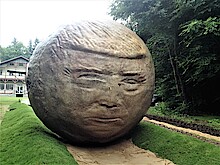Sculpture Experiment Silkeborg - Callum Morton
2017
In connection with European Capital of Culture Aarhus 2017, new works by internationally known artist Callum Morton is shown in the sculpture park at Art Centre Silkeborg Bad in Denmark.
Sisyphus
When Callum Morton a couple of years ago for the first time visited the historic and contemporary milieu, he coincidentally re-read Albert Camus’ The Myth of Sisyphus at the same time. This lead to the developing of a new piece relating and interpreting several dimensions of the specific site – historically, architecturally and existentially. In addition, the piece is reading the myth in relation to contemporary living and a global context of society.
The old myth about Sisyphus tell about a man who as a punishment for defying the gods, had to push a rock up a mountain for eternity.
Door to Door
On three spots in the park one finds the sound piece. Disturbing sounds are heard from the grounds, like from another world, behind locked doors. The whole area has a rich history reaching back to last quarter of 19th Century and with his contemporary piece the artist in glimpses open to corners of this history. At the same time, the piece points general existential notions like being trapped and unfree.
----
Callum Morton is born 1965 in Canada. He lives and works in Australia.
----
Read more beneath about his interpretation of the Sisyphus myth in relation to the site and to existence (nb. This text reflects the artist’s subjective experience and interpretation of the site and is not necessarily coherent with the exact history).
Callum Morton’s project ‘Sisyphus’ at Art Centre Silkeborg Bad reflects on the shifting identities of the buildings and their surroundings since their inception. From their origins as a sanatorium and health spa in the late 19th Century, to a Gestapo headquarters during the German occupation, a refugee camp (on two occasions) and finally to a series of museums, both for art and the site’s history, which includes, rather disturbingly, a small museum of Nazi memorabilia inside one of the many bunkers surrounding the site.
These transformations are not uncommon in the history of art institutions. The Tate Britain was once a prison, the Louvre was a garrison fortress, the Hamburger Bahnhoff in Berlin a train station and countless museums were once residences of one type or another. What is perhaps remarkable in the case of Silkeborg Bad is that not only have these transformations occured rather frequently, but that each one seems to describe different types of internment or entrapment, indeed in Morton’s eyes, different types of purgatory. From the infirm hoping to cure their tuberculosis, to Nazi’s experiencing a type of forced entrapment during their obviously unwelcome occupation of a foreign country, refugees seeking refuge but in a desperately uncertain space between worlds and finally an art museum that, as a matter of course, imprisons objects, events, space and time in a type of fixed atrophy.
In a small bookshop in London last year Morton picked up a copy of Albert Camus’ Myth of Sisyphus, a book he hadn’t read for many years. The final chapter recounts the story of Sisyphus, who is condemned to roll a large boulder up and down a hill for all eternity as punishment for defying the gods. Employed by Camus as the prototypical illustration of an existential life, the myth seemed in that moment, strangely appropriate to the history of Silkeborg Bad.
On the one hand it describes a figure trapped inside the eternal repetition of a miserable act of hard labour, which for all the world seems a pitiless description of unfreedom and entrapment. The transformations of the Silkeborg Bad buildings from one space of unfreedom to another seem equally to describe a type Nietzschean ‘eternal return.’ Indeed more recently the possibility of the site again housing refugees has been discussed.
Morton’s installations at Silkeborg Bad both reflect on these historical transformations but also updates them.
His re-purposing of one of the buildings is willfully virtual as is his specific reworking of the Myth of Sisyphus. At the center of the Silkeborg Bad complex a large boulder with a curious form is prepared to roll slowly up and down the hill by itself. In this new version Sisyphus is absent.
He is not happy in the sense that Camus suggests he might be at the end of his book by accepting his fate, rather he is happy under capitalism, enjoying some leisure time in retirement while the machines work.
A happy little zombie.


